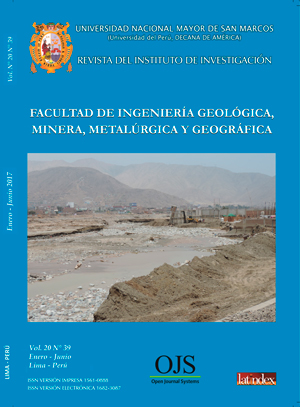Study of the electrocoagulation to control the turbidity and the pH in the treatment of polymethalic metallurgical mineral effluents
DOI:
https://doi.org/10.15381/iigeo.v20i39.14174Keywords:
geodynamics, landslides, geodesy, geotechnicsAbstract
Electrocoagulation is an electrochemical method to remove contaminants, using an anode and a cathode, where chemical and physical reactions occur, between ions with opposite charge, which facilitates the attraction of the individual particles that form a flocculus with Greater density than the individual particles, being able to decant them spontaneously to form the anodic mud that will be treated like dangerous solid residue. The extraction of mineral concentrates generates effluents and when the variables for contaminated discharges are not controlled, the rivers and the sea are impacted. For hundreds of years, electrocoagulation has been discovered as a treatment for industrial waters and is now taking up the interest of the application of this technology, because of its low cost compared to other technologies. In Colombia this technology is applied in the textile industry in the process of natural and synthetic fibers, dyeing and stamping, as well as in the agricultural sector. It is thus that electrocoagulation is profiled, as a process that can be innovated for the treatment of water from the metallurgical mining processes and optimize control parameters. The reuse and recirculation are operations that help in the management of the water, but it is necessary to carry out treatments to the waste water so that when discharging them, the pollution of the sea and the rivers is avoided, in this way the water resource would be protected Which in the future is known to be scarce. The hypothesis raised in this research is that electrocoagulation will allow control of turbidity and pH in the treatment of metallurgical mining effluents, which will be a contribution for companies to comply with the mining metallurgical discharges law. The result before treatment was: absorbance 2,223 and 2769,175 mg / l, total suspended solids, pH 10, pH meter efficiency 95%. After treatment was: absorbance 0.045 and 46.68 mg / l of total suppressed solids, pH = 8, pH meter efficiency 98%. Area 0.0925m2, Anode and Cathar side 0.3041 m2, Current current 86.47 A / m2, 2 V and 5 A The objective of this research was to study electrocoagulation to control turbidity and pH in the treatment of polymetallic metallurgical mining effluents The result will be the uliram methodology for the electrocoagulation applied to polymetallic metallurgical mining effluents. The participating units are full-time and full-time faculty and graduate students.Downloads
Published
Issue
Section
License
Copyright (c) 2017 Marilú Calderón, Vidal Aramburú

This work is licensed under a Creative Commons Attribution-NonCommercial-ShareAlike 4.0 International License.
AUTHORS RETAIN THEIR RIGHTS:
a. Authors retain their trade mark rights and patent, and also on any process or procedure described in the article.
b. Authors retain their right to share, copy, distribute, perform and publicly communicate their article (eg, to place their article in an institutional repository or publish it in a book), with an acknowledgment of its initial publication in the Rev. Inst. investig. Fac. minas metal cienc. geogr.
c. Authors retain theirs right to make a subsequent publication of their work, to use the article or any part thereof (eg a compilation of his papers, lecture notes, thesis, or a book), always indicating the source of publication (the originator of the work, journal, volume, number and date).






